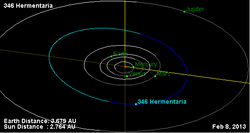Astronomy:346 Hermentaria
 Orbital diagram | |
| Discovery | |
|---|---|
| Discovered by | Auguste Charlois |
| Discovery date | 25 November 1892 |
| Designations | |
| (346) Hermentaria | |
| Pronunciation | /hɜːrmənˈtɛəriə/ |
| Named after | Herment |
| 1892 P | |
| Minor planet category | Main belt |
| Orbital characteristics[1] | |
| Epoch 31 July 2016 (JD 2457600.5) | |
| Uncertainty parameter 0 | |
| Observation arc | 123.38 yr (45,066 d) |
| |{{{apsis}}}|helion}} | 3.08 astronomical unit|AU (460.65 Gm) |
| |{{{apsis}}}|helion}} | 2.51 AU (376.15 Gm) |
| 2.80 AU (418.40 Gm) | |
| Eccentricity | 0.10098 |
| Orbital period | 4.68 yr (1,708.5 d) |
| Mean anomaly | 188.671° |
| Mean motion | 0° 12m 38.578s / day |
| Inclination | 8.74967° |
| Longitude of ascending node | 91.9628° |
| 292.035° | |
| Physical characteristics | |
| Dimensions | 106.52±2.2 km[1] 93.27±3.05 km[2] |
| Mass | (6.33±0.18)×1018 kg[2] |
| Mean density | 14.89±1.52 g/cm3[2] |
| Rotation period | 28.43 h (1.18 d)[1] 17.790 h (0.74 d)[3] 28.523 h (1.19 d)[4] |
| Geometric albedo | 0.2189±0.009 |
| S | |
| Absolute magnitude (H) | 7.13 |
Hermentaria (minor planet designation: 346 Hermentaria) is a very large main-belt asteroid. It was discovered by French astronomer Auguste Charlois on 25 November 1892, in Nice. It is probably named for the town of Herment in the region of Auvergne, France.[5] The asteroid is orbiting the Sun with a period of 4.68 years and an eccentricity (ovalness) of 0.10. The orbital plane is inclined by 8.7° to the plane of the ecliptic.
This body has a rotation period of 28.523±0.001 h during which it varies in brightness with an amplitude of 0.14±0.01 magnitude.[4] It has a cross-section diameter of ~100 km. 346 Hermentaria is classified as a (stony) S-type asteroid, indicating a siliceous mineralogical composition. The near infrared spectra of this object show absorption features that suggest a mix of the minerals clinopyroxene and orthopyroxene.[6] It may be thermally–evolved, having at least partially melted at some point.[7] The overall shape resembles a prolate spheroid.[3]
References
- ↑ 1.0 1.1 1.2 "346 Hermentaria (1892 P)". JPL Small-Body Database. NASA/Jet Propulsion Laboratory1. https://ssd.jpl.nasa.gov/sbdb.cgi?sstr=346;cad=1.
- ↑ 2.0 2.1 2.2 Carry, B. (December 2012), "Density of asteroids", Planetary and Space Science 73: 98–118, doi:10.1016/j.pss.2012.03.009, Bibcode: 2012P&SS...73...98C. See Table 1.
- ↑ 3.0 3.1 Wang, Xiaobin et al. (January 2016), "Studies for slowly rotating asteroids (168) Sibylla and (346) Hermentaria", Asteroids: New Observations, New Models, Proceedings of the International Astronomical Union, IAU Symposium 318: pp. 185–192, doi:10.1017/S1743921315008777, Bibcode: 2016IAUS..318..185W
- ↑ 4.0 4.1 Pilcher, Frederick (July 2016), "Rotation Period Determinations for 123 Brunhild, 314 Rosalia 346 Hermentaria, 633 Zelima, and 730 Athanasia", Bulletin of the Minor Planets Section of the Association of Lunar and Planetary Observers 43 (3): 222−224, Bibcode: 2016MPBu...43..222P
- ↑ Schmadel, Lutz D. (November 11, 2013), Dictionary of Minor Planet Names, Berlin Heidelberg: Springer, p. 66, ISBN 9783662066157, https://books.google.com/books?id=eHv1CAAAQBAJ&pg=PA66
- ↑ Hardersen, Paul S. et al. (March 2006), "Near-infrared spectral observations and interpretations for S-asteroids 138 Tolosa, 306 Unitas, 346 Hermentaria, and 480 Hansa", Icarus 181 (1): 94–106, doi:10.1016/j.icarus.2005.10.003, Bibcode: 2006Icar..181...94H
- ↑ Hardersen, P. S. et al. (March 2005), "Detailed Mineralogical Characterizations of Four S-Asteroids: 138 Tolosa, 306 Unitas, 346 Hermentaria, and 480 Hansa", 36th Annual Lunar and Planetary Science Conference, March 14–18, 2005, in League City, Texas 1240, Bibcode: 2005LPI....36.1240H
External links
- 346 Hermentaria at AstDyS-2, Asteroids—Dynamic Site
- 346 Hermentaria at the JPL Small-Body Database
 |

